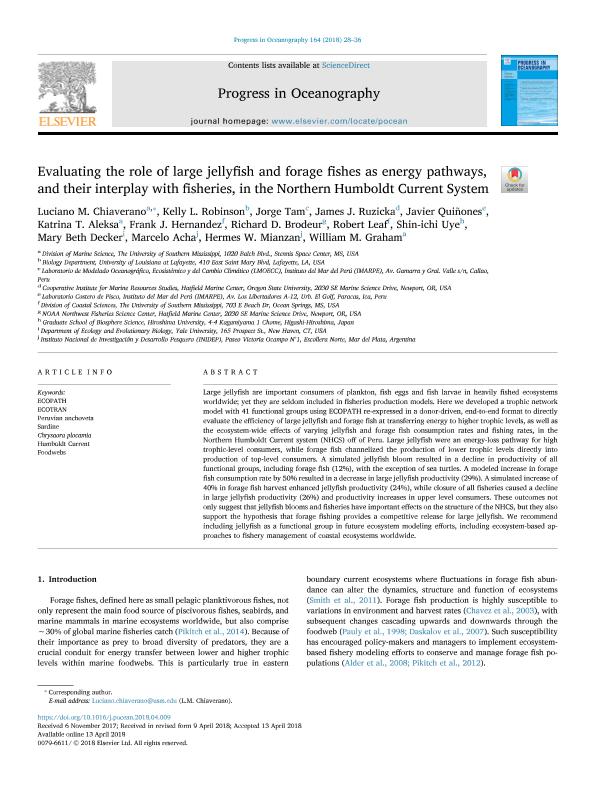Mostrar el registro sencillo del ítem
dc.contributor.author
Chiaverano, Luciano

dc.contributor.author
Robinson, Kelly L.
dc.contributor.author
Tam, Jorge
dc.contributor.author
Ruzicka, James J.
dc.contributor.author
Quiñones, Javier
dc.contributor.author
Aleksa, Katrina T.
dc.contributor.author
Hernandez, Frank J.
dc.contributor.author
Brodeur, Richard D.
dc.contributor.author
Leaf, Robert
dc.contributor.author
Uye, Shin-ichi
dc.contributor.author
Decker, Mary Beth
dc.contributor.author
Acha, Eduardo Marcelo

dc.contributor.author
Mianzan, Hermes Walter

dc.contributor.author
Graham, William M.
dc.date.available
2020-03-26T14:50:11Z
dc.date.issued
2018-05
dc.identifier.citation
Chiaverano, Luciano; Robinson, Kelly L.; Tam, Jorge; Ruzicka, James J.; Quiñones, Javier; et al.; Evaluating the role of large jellyfish and forage fishes as energy pathways, and their interplay with fisheries, in the Northern Humboldt Current System; Pergamon-Elsevier Science Ltd; Progress In Oceanography; 164; 5-2018; 28-36
dc.identifier.issn
0079-6611
dc.identifier.uri
http://hdl.handle.net/11336/100885
dc.description.abstract
Large jellyfish are important consumers of plankton, fish eggs and fish larvae in heavily fished ecosystems worldwide; yet they are seldom included in fisheries production models. Here we developed a trophic network model with 41 functional groups using ECOPATH re-expressed in a donor-driven, end-to-end format to directly evaluate the efficiency of large jellyfish and forage fish at transferring energy to higher trophic levels, as well as the ecosystem-wide effects of varying jellyfish and forage fish consumption rates and fishing rates, in the Northern Humboldt Current system (NHCS) off of Peru. Large jellyfish were an energy-loss pathway for high trophic-level consumers, while forage fish channelized the production of lower trophic levels directly into production of top-level consumers. A simulated jellyfish bloom resulted in a decline in productivity of all functional groups, including forage fish (12%), with the exception of sea turtles. A modeled increase in forage fish consumption rate by 50% resulted in a decrease in large jellyfish productivity (29%). A simulated increase of 40% in forage fish harvest enhanced jellyfish productivity (24%), while closure of all fisheries caused a decline in large jellyfish productivity (26%) and productivity increases in upper level consumers. These outcomes not only suggest that jellyfish blooms and fisheries have important effects on the structure of the NHCS, but they also support the hypothesis that forage fishing provides a competitive release for large jellyfish. We recommend including jellyfish as a functional group in future ecosystem modeling efforts, including ecosystem-based approaches to fishery management of coastal ecosystems worldwide.
dc.format
application/pdf
dc.language.iso
eng
dc.publisher
Pergamon-Elsevier Science Ltd

dc.rights
info:eu-repo/semantics/openAccess
dc.rights.uri
https://creativecommons.org/licenses/by-nc-sa/2.5/ar/
dc.subject
CHRYSAORA PLOCAMIA
dc.subject
ECOPATH
dc.subject
ECOTRAN
dc.subject
FOODWEBS
dc.subject
HUMBOLDT CURRENT
dc.subject
PERUVIAN ANCHOVETA
dc.subject
SARDINE
dc.subject.classification
Biología Marina, Limnología

dc.subject.classification
Ciencias Biológicas

dc.subject.classification
CIENCIAS NATURALES Y EXACTAS

dc.title
Evaluating the role of large jellyfish and forage fishes as energy pathways, and their interplay with fisheries, in the Northern Humboldt Current System
dc.type
info:eu-repo/semantics/article
dc.type
info:ar-repo/semantics/artículo
dc.type
info:eu-repo/semantics/publishedVersion
dc.date.updated
2020-03-25T14:00:47Z
dc.journal.volume
164
dc.journal.pagination
28-36
dc.journal.pais
Estados Unidos

dc.description.fil
Fil: Chiaverano, Luciano. Consejo Nacional de Investigaciones Científicas y Técnicas; Argentina. University Of Southern Mississippi; Estados Unidos
dc.description.fil
Fil: Robinson, Kelly L.. University of Louisiana at Lafayette; Estados Unidos
dc.description.fil
Fil: Tam, Jorge. Instituto del Mar del Perú; Perú
dc.description.fil
Fil: Ruzicka, James J.. Oregon State University; Estados Unidos
dc.description.fil
Fil: Quiñones, Javier. Instituto del Mar del Perú; Perú
dc.description.fil
Fil: Aleksa, Katrina T.. University Of Southern Mississippi; Estados Unidos
dc.description.fil
Fil: Hernandez, Frank J.. University Of Southern Mississippi; Estados Unidos
dc.description.fil
Fil: Brodeur, Richard D.. Northwest Fisheries Science Center; Estados Unidos
dc.description.fil
Fil: Leaf, Robert. University Of Southern Mississippi; Estados Unidos
dc.description.fil
Fil: Uye, Shin-ichi. Hiroshima University; Japón
dc.description.fil
Fil: Decker, Mary Beth. University of Yale; Estados Unidos
dc.description.fil
Fil: Acha, Eduardo Marcelo. Consejo Nacional de Investigaciones Científicas y Técnicas. Centro Científico Tecnológico Mar del Plata. Instituto de Investigaciones Marinas y Costeras. Subsede Instituto Nacional de Investigación y Desarrollo Pesquero; Argentina
dc.description.fil
Fil: Mianzan, Hermes Walter. Consejo Nacional de Investigaciones Científicas y Técnicas. Centro Científico Tecnológico Mar del Plata. Instituto de Investigaciones Marinas y Costeras. Subsede Instituto Nacional de Investigación y Desarrollo Pesquero; Argentina
dc.description.fil
Fil: Graham, William M.. University Of Southern Mississippi; Estados Unidos
dc.journal.title
Progress In Oceanography

dc.relation.alternativeid
info:eu-repo/semantics/altIdentifier/url/http://linkinghub.elsevier.com/retrieve/pii/S0079661117303312
dc.relation.alternativeid
info:eu-repo/semantics/altIdentifier/doi/http://dx.doi.org/10.1016/j.pocean.2018.04.009
Archivos asociados
